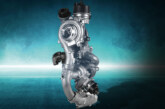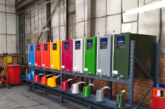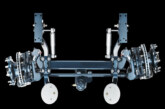What’s the importance of brake fluid?

Witham Group, one of the UK’s leading independent lubricant manufacturers, is highlighting the critical role of regular brake maintenance in ensuring vehicle safety.
While many assume brake pads are the primary cause of brake issues, lack of clean brake fluid and the build-up of contaminants are more often the culprit behind performance fade and potential failure. Brake fluid transfers the force from the brake pedal to the brake pads and discs, requiring high-quality formulation for reliable and responsive braking. Keeping brakes free of residue with proper cleaning also improves the braking performance and lifespan of the brake system.
Witham Group’s new brake and clutch cleaner is the latest product to be added to its range of reliable brake fluids. The cleaner is said to be an effective cleaning solvent, formulated to remove oil, grease, excess brake fluid and other contaminants from brake components of automotive, and all types of agricultural and commercial vehicles. It has a fast drying, fast evaporation formula and ensures residue free surfaces, which in turn offers more efficient and safer braking and can help delay premature wear and tear.
How brake fluid works and why it is important
Brake fluid, a hydraulic fluid, transmits pressure from the brake pedal to the brake callipers or wheel cylinders, activating the brakes. Its non-compressible nature provides a solid and consistent pedal feel. However, glycol-ether based brake fluids, the most common type, are hygroscopic, meaning they absorb moisture from the air.
This moisture absorption has two significant negative impacts:
Corrosion: Water within the brake system can cause internal corrosion of steel components.
Reduced boiling point: As brake fluid absorbs water, its boiling point decreases. If the fluid temperature exceeds 100°C (the boiling point of water), the water turns to steam, which is compressible. This can lead to a spongy brake pedal or, in severe cases, complete brake failure.
Understanding DOT standards
Brake fluids are classified by the Department of Transportation (DOT) into categories like DOT3, DOT4, and DOT5.1. These classifications are based on the fluid’s dry (fresh) and wet (moistureabsorbed) boiling points. Most vehicles use DOT4 brake fluid, but the vehicle’s handbook should always consulted for the correct specification.
Despite its importance, brake fluid is often the most neglected component in a vehicle’s braking system. While MOT inspections check fluid levels and visual contamination, they don’t assess the fluid’s moisture content or boiling point.
Glycol-ether based brake fluid should typically be replaced every two years, as recommended by most manufacturers. Regular changes are essential to maintain braking performance, prevent corrosion, and ensure driver safety.
Witham’s brake fluid range:
- Qualube brake and clutch cleaner: A highly effective cleaning solvent, formulated to remove grease, oil, brake fluid and other contaminants from the vital braking components. It is a fast-drying cleaner, improving brake performance and extending the lifespan of brake systems.
- Qualube brake fluid DOT 5.1: Qualube brake dluid DOT 5.1 is a glycol ether-based fluid formulated exclusively from virgin materials to exceed the requirements of the major internationally recognised hydraulic brake fluid standards: FMVSS No 116 DOT5.1, SAE J1704 and 1SO4925 Class 5.1.
- Qualube brake fluid DOT 4: A glycol ether-based fluid formulated exclusively from virgin materials to exceed the requirements of the major internationally recognised hydraulic brake fluid standards: FMVSS No 116 DOT 4, SAE J1704 and ISO4925 Class 4.
- Qualube LHM plus fluid: Mineral-based hydraulic fluid for Citroen hydro-pneumatic and braking systems (green reservoirs).









